Gahtan Lab - Research
Students pursue research in a range of topics related to behavioral neuroscience. Two broad areas of focus, Sensory-motor circuits and Evolutionary psychology, Imagine reaching out your hand to grab a coffee mug. Surprisingly, what's so simple for your mind depends on horrendously complex brain mechanisms that transform visual inputs from your retinas into motor outputs to muscles in your arm. How neural circuits transform 'sensory coordinates' into 'motor coordinates' is a general interest in the lab. Sensory-motor transformations depend on precise patterns of connections among neurons. We and others study this neural circuit microstructure in tiny zebrafish larvae because of special technical advantages: they are transparent, have relatively Top-down view of a zebrafish larva's head (nose at right, eyes facing up and down). Green: neurons expressing a genetically-encoded fluorescent calcium indicator. Calcium increases when neurons fire so activity in specifc neurons can be measured by their brightness. Here's an example of our work using this method. Purple: 'premotor' neurons in the hindbrain that carry movement signals to the spinal cord. To the right: Trigeminal sensory nerve entering the hindbrain in a living zebrafish larvae. The trigeminal is the nerve that carries touch and pain signals from the head, including tooth aches! Zebrafish behavior Zebrafish, humans, and all vertebrates share many brain structures and molecular mechanisms within cells so this type of work has broad relevance. Here's a link to my work in this area. Neurological disease modeling using zebrafish Precise genetic manipulations can create zebrafish useful for studying specific human diseases and our lab contributes to this work. Two examples follow. I am also interested in evolutionary psychology, social neuroscience, and behavioral genetics. Here are some student projects I have supervised in those areas. *Bass EC, *Stednitz SJ, *Simonson K, *Shen T, Gahtan E. (2014) Physiological stress reactivity and empathy following social exclusion: a test of the defensive emotional analgesia hypothesis. Social Neuroscience, 9(5): 504-13. *Mark, Q., Gahtan, E. (2013). Did sexual selection and culture interact in the evolution of human height? Journal of Social, Evolutionary, and Cultural Psychology, 7(2), 121-137. Thesis: Kinship emotions and parenthood as motivators of concern for the distant future: a qualitative study. Jones, Stefanie V. (Cal Poly Humboldt, 2010-05) Thesis: Genetic predisposition for hypnotic susceptibility: an introductory study on the potential of genetic predictors. Wannigman, Kyle David (Cal Poly Humboldt, 2014-12) *Bishop, B.H., *Spence-Chorman, N., Gahtan, E. (2016). Three-dimensional motion tracking reveals a diving component to visual and auditory escape swims in zebrafish larvae. Journal of Experimental Biology, 219(Pt 24): 3981-3987. DOI: 10.1242/jeb.147124. *Stednitz SJ, *Freshner B, *Shelton S, *Shen T, *Black D, Gahtan E. (2015). Selective toxicity of L-DOPA to dopamine transporter-expressing neurons and locomotor behavior in zebrafish larvae. Neurotoxicol Teratol. 52(Pt A):51-6. doi: 10.1016/j.ntt.2015.11.001. *Bass EC, *Stednitz SJ, *Simonson K, *Shen T, Gahtan E. (2014) Physiological stress reactivity and empathy following social exclusion: a test of the defensive emotional analgesia hypothesis. Social Neuroscience, 9(5): 504-13. *Mark, Q., Gahtan, E. (2013). Did sexual selection and culture interact in the evolution of human height? Journal of Social, Evolutionary, and Cultural Psychology, 7(2), 121-137. *Griffiths, B.B., Schoonheim, P.J., Ziv, L., *Voelker, L., Baier, H., Gahtan, E. (2012). A zebrafish model of glucocorticoid resistance shows serotonergic modulation of the stress response. Frontiers Beh Neuro, 6: 68 *Stobb, M., *Peterson, J.M., Mazzag, B., Gahtan, E. (2012). Graph theoretical model of a sensorimotor connectome in zebrafish. PLoS One, 7(5):e37292. *Peterson, J.M., *Stobb, M., Mazzag, B., Gahtan, E. (2012). Computational Graph Theoretical Model of the Zebrafish Sensorimotor Pathway. Conference Proceedings of the American Institute of Physics (AIP), 1368, pp. 139-142; doi: http://dx.doi.org/10.1063/1.3663479
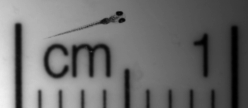 simple brains, and specific neurons can be studied using genetics and other methods, all of which allows neuron-behavior relationships to be studied in unique ways. Following are some examples from our lab.
simple brains, and specific neurons can be studied using genetics and other methods, all of which allows neuron-behavior relationships to be studied in unique ways. Following are some examples from our lab.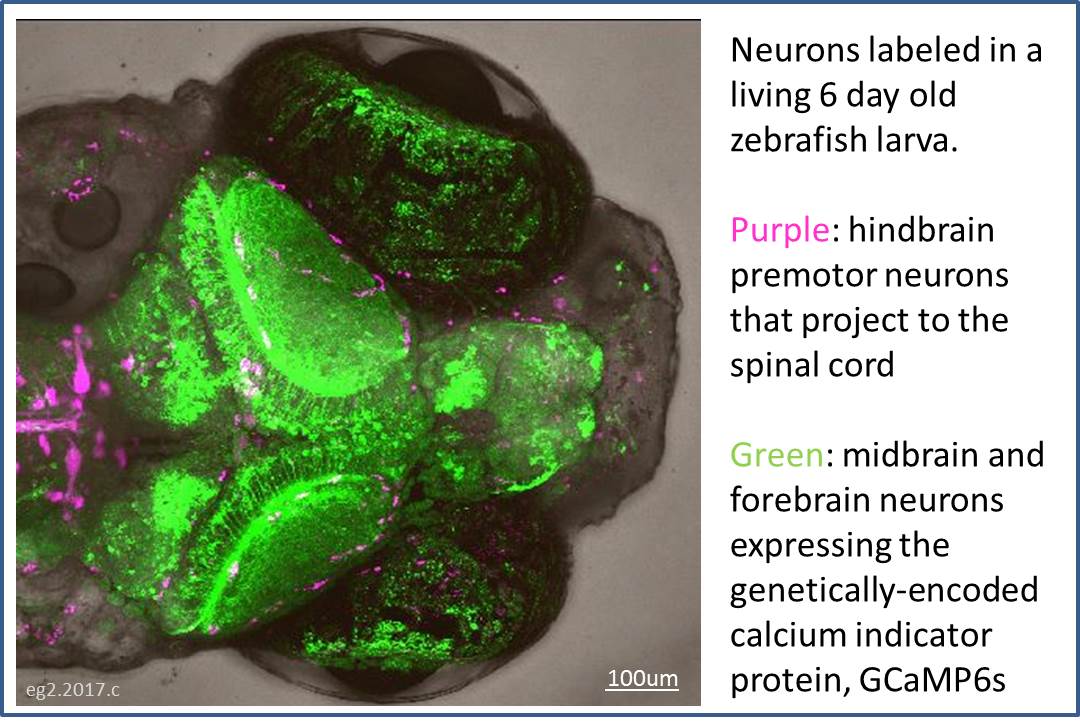 Neural activity mapping in sensory-motor circuits.
Neural activity mapping in sensory-motor circuits. 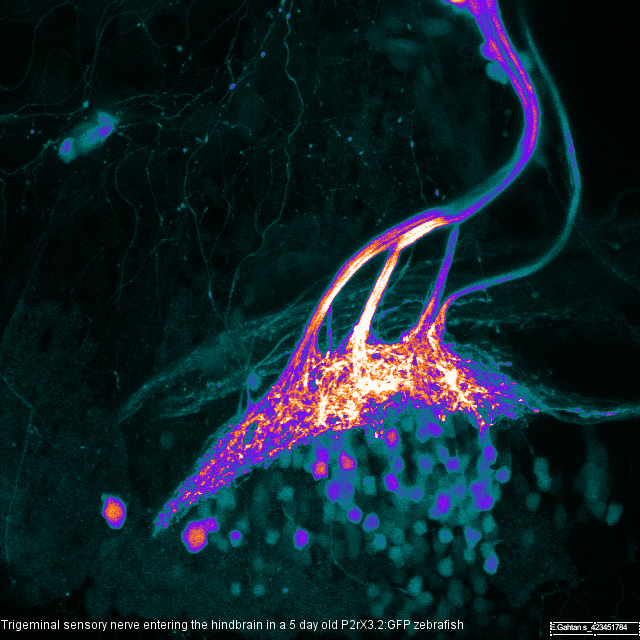
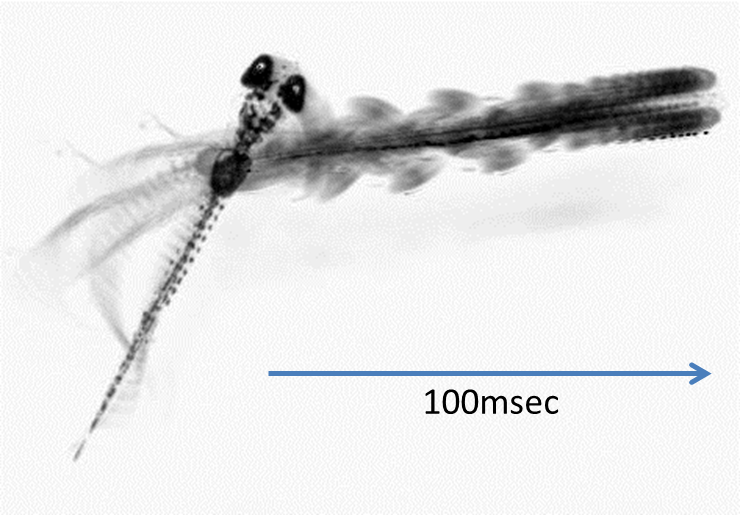 We use high-speed cameras to study sensory-motor behavior including speed, direction, and sensitivity to sensory inputs, to link neurons and circuits to behavioral functions. Picture: ~1/10th sec of a larva swimming, with video frames overlaid to show the movement path. They are quick!
We use high-speed cameras to study sensory-motor behavior including speed, direction, and sensitivity to sensory inputs, to link neurons and circuits to behavioral functions. Picture: ~1/10th sec of a larva swimming, with video frames overlaid to show the movement path. They are quick!  Stress-related disorders. A biological stress response from a sudden fright turns off automatically in part because of the hormone cortisol. Stress increases cortisol but then cortisol binds to a receptor in neurons that turns off the stress response (inhibitory feedback). We studied zebrafish with a broken cortisol receptor gene. It had elevated behavioral and biological stress indicators which anti-depressant drugs moderated. Read an article on this work.
Stress-related disorders. A biological stress response from a sudden fright turns off automatically in part because of the hormone cortisol. Stress increases cortisol but then cortisol binds to a receptor in neurons that turns off the stress response (inhibitory feedback). We studied zebrafish with a broken cortisol receptor gene. It had elevated behavioral and biological stress indicators which anti-depressant drugs moderated. Read an article on this work.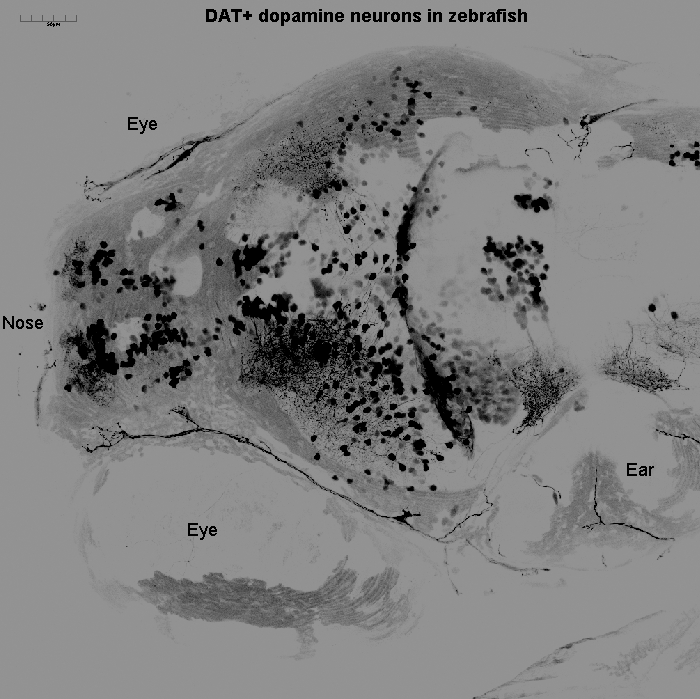 Movement disorders. The neurotransmitter dopamine is important for motor control. In Parkinson’s disease a specific type of dopamine neuron dies, ones that makes the dopamine transporter (DAT) protein. We used a zebrafish in which all DAT neurons were genetically labeled with a green fluorescent protein, and tested how certain drugs affected the health of DAT neurons. Read an article and thesis on this work.
Movement disorders. The neurotransmitter dopamine is important for motor control. In Parkinson’s disease a specific type of dopamine neuron dies, ones that makes the dopamine transporter (DAT) protein. We used a zebrafish in which all DAT neurons were genetically labeled with a green fluorescent protein, and tested how certain drugs affected the health of DAT neurons. Read an article and thesis on this work.Evolutionary psychology related projects
Publications * = Cal Poly Humboldt student coauthor

